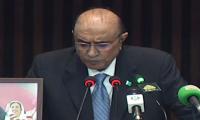ISLAMABAD: Pakistan is unlikely to meet the targets of sustainable development goals set for 2030 to provide education for all with the current allocation of pending 2 per cent of its GDP on education, annual report of UNICEF says.
The annual report of United Nations Children’s Emergency Fund (UNICEF) launched last month says, Pakistan has more than 5.6 million out-of-school children of primary school age. The government of Pakistan reports spending about 2 per cent of GDP on education. These investment levels are below the estimated 5.5 per cent of GDP that will be required to provide education for all by 2030.
“There are also large wealth-related gaps in school attendance and retention children in the richest 20 per cent of the population get nearly nine more years of schooling, on average, than children in the poorest 20 per cent. This wealth gap is magnified by gender disadvantages among the poorest girls and by regional disparities. While Pakistan is making national progress in primary school completion, some groups – notably poor rural girls – have been left behind,” the report says.
Similarly the report says Pakistan and Nigeria are the only two countries where the under-five mortality rate (U5Mr) in the wealthiest and the poorest household is above the sustainable development goals (SDG) target, and marked disparities persist between regions. The report says while the richest 20 per cent will have to cut mortality by more than half to achieve the target by 2030, the poorest 20 per cent must achieve a reduction of three quarters.
While analysing another indicator, the report highlighted glaring disparities in antenatal care and skilled birth attendance at the regional level. The gap between the richest and poorest households are respectively four and six times more likely to receive antenatal care (at least four visits) than those from the poorest in Bangladesh and Pakistan.
“Five countries will account for more than half of the global burden of under-five deaths: India (17 per cent), Nigeria (15 per cent), Pakistan (8 per cent), the democratic republic of the Congo (7 per cent) and Angola (5 percent),” the report says.
While appreciating the initiative of cash transfers programmes the report says, this programme has helped improve rates of transition to higher levels of education. Pakistan’s female School Stipend Programe reduced girls’ labour- force participation by as much as 5 per cent. In Bangladesh, a cash transfer programme was successful in encouraging girls to enroll, particularly in secondary school, and in delaying marriage.
It is pertinent to mention here that under Punjab Education Sector Reform Programme, the government of Punjab is implementing an activity that offers cash stipends to girls of grades (6-10) of government schools in selected districts with the objectives of improving enrollment, increasing retention, reducing gender disparities and enhancing female prestige.
According to Punjab Education Department, during FY 2013-14, the programme distributed stipends worth Rs1.5 billion to 411,000 girls enrolled in grades 6-10 in government schools in 16 out of 36 districts of Punjab namely Bahawalnagar, Bahwalpur, Bhakkar, Chinniot, DG khan, Jhang, Kasur, Khanewal, Layyah, Lodhran, Muzaffargarh, Okara, Pakpattan, Rajanpur, Rahim Yar Khan and Vehari. The beneficiary girls are given Rs2,400 per year, in four equal quarterly payments subject to the condition of 80% attendance rate during the period. The stipend programme is being administered through district education administrations and delivered through government postalservice system.
The Punjab Education Department report further says that a pilot activity of the supplemental stipend pilot project (Phase-I) was started in 68 selected schools from April, 2013 for disbursement increased stipend. The incentive package for supplemental stipend Phase-I programme is to increase the stipend from Rs600 to Rs900 for girls in grades 6-8, and Rs600 to Rs1200 for girls in grades 9-10. For Phase-I, 68 schools were selected by World Bank across six tehsils (Darya Khan, KallurKot, Mankera, Kasur, Kot RadhaKishan, and Chunian) in two stipend districts i.e. Bhakkar and Kasur.
During FY 2014-15, another pilot of Supplemental Stipends Pilot Project (SSPP) Phase-II has been started to (i) increase school transitions of girls from primary schools to middle schools and from middle schools to secondary schools, and (ii) increase retention in grades 6-10. SSPP-II has been implemented in 18 tehsils of 6 districts, namely DG Khan, Kot Chuta and Taunsa in DG Khan; Chaubara, Karor Lalisan and Layyah in Layyah; Dunya Pur, KarorPacca and Lodhran in Lodhran; Alipur, Jatoi and Muzaffargarh in Muzaffargarh; Khanpur, Rahimyar Khan and Sadiqabad in Rahimyar Khan; and Jampur, Rajanpur and Rojhan in Rajanpur. Under SSPP-II, 659 rural government schools in around 3600 mauzas have been categorized into three groups (“Treatment I – 143 schools”, “Treatment II – 155 schools” and “Control – 361 schools”).
The following increased incentive packages are being offered to beneficiary girls in grades 6-10 in each of these groups: Treatment I: (i) Girls in grades 6-8 will receive Rs900 per quarter based on 80% attendance (ii) Girls in grades 9-10 will receive Rs1200 per quarter based on 80% attendance. Treatment II: (i) Girls in grades 6-8 will receive Rs900 per quarter based on 80% attendance (ii) Girls in grade 9-10 receive Rs2400 upon progression to this grade based on 80% attendance in the first quarter of the school year + Rs1200 per quarter based on 80% attendance. Control: Girls in grades 6-10 will receive Rs600 per quarter based on 80% attendance. This is the same benefit structure as in the original stipends programme.
JUI-F filed a petition through advocate Kamran Murtaza
New data from 187 countries shows that the estimated number of deaths from viral hepatitis increased from 1.1 million...
APTMA also drew the attention of the finance minister toward high taxes and persistent delays in refunds have squeezed...
The guard appeared at the Westminster Magistrates Court on Wednesday afternoon with his lawyer Moeen Khan
Ogra determines the natural gas tariff for domestic sector consumers and LNG price separately for power sector
The chief minister directed prompt completion of the Lahore Ring Road SL-3 project and urged immediate action







